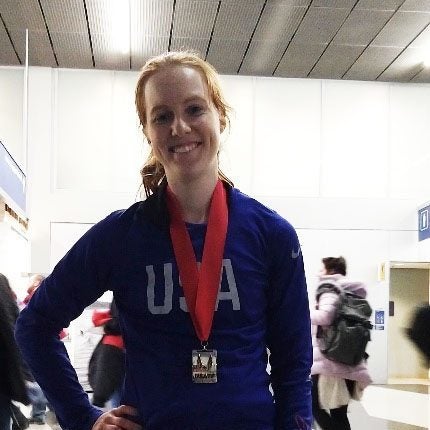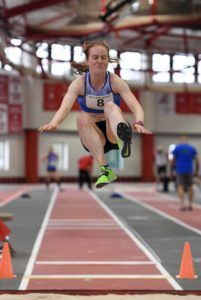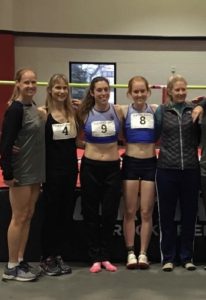
Amanda Pasko is a first-year masters student studying nutritional epidemiology at the Harvard Chan School. A graduate of Rice University with a degree in Kinesiology and Sports Medicine and Summa Cum Laude honors, Amanda has long been involved in fitness and exercise as a coach, mentor, and athlete. She is a seasoned track and field runner, with many competitions and titles to her credit including most recently placing second in a national competition for the indoor heptathlon.
When and how did your interest in fitness and exercise start?
I first tried track and field at a low-key summer program when I was nine, and I immediately enjoyed the variety in the events, particularly the jumps, and the many fun ways to push yourself to be the best that you could be. I did more and bigger meets each year and continued to do well in unique combinations of events, such as the javelin throw, high jump, and 800 meters. When I started to train harder at the end of high school and in college, fitness training became a larger part of practicing than rehearsing the events themselves, and I loved the feeling of pushing yourself in running and strength training workouts and seeing the outcome. I also became interested in exercise physiology, nutrition, psychology, and the many ways that an individual’s physiology can be manipulated to improve performance and recovery, and I liked the way that my interests in science and sports could tie together.
As a first-year masters student in nutritional epidemiology here at Harvard Chan, what has your experience been like? Why did you pick this particular program? What (research) are you working on now?
I have enjoyed my first year at Harvard Chan very much, although the recent weeks have obviously been different than anticipated. I have taken some epidemiology and biostatistics courses that gave background on the theories behind research, courses in nutrition, and electives in social and behavioral science and entrepreneurship. I have learned more about what drives health-related behaviors and how to design effective studies. Nutrition had been a favorite topic of mine in college and related closely to my interest in track and field and physical activity. I also like the way that it relates to everyone’s daily life. I knew that this program would enable me to learn more about nutrition as well as related topics that would help me to use nutritional knowledge in different ways. Some of my research interests include the effects of energy balance on metabolism and the endocrine system, the effect of physical activity on metabolism, and the effect of vitamin D on many systems in the body. In the long-term, I would like to become a dietitian concentrating in sports dietetics, and provide physically-active people with evidence-based advice.

I understand that you have been training several hours a day for the national track and field heptathlon. What drew to you participating? Can you tell us a little about your training process, what does it take to prepare for one? How has your training been impacted, if it has been, by the current COVID-19 situation?
I competed in track and field in college in the multi-events. Women typically do a pentathlon indoors (consists of hurdles, high jump, shot put, long jump, and 800 meters), and a heptathlon outdoors (adds the javelin and 200 meters). For men, the indoor multi-event is typically a heptathlon (60 meters, long jump, shot put, high jump, 60-meter hurdles, pole vault, and 800 or 1000 meters) and a decathlon outdoors (adds the javelin, discus, and an extra running event). Most meets do not have multi-events, so athletes usually train for all of the events and compete in a subset at each meet. Because the women’s multi-events will switch to the longer versions, likely for the 2028 Olympics, the US has started to have national championships for women in the longer multi-events. I wanted to keep on training and competing after college, and I improved a lot the summer and subsequent winter after I finished college. I had tried the additional events in the decathlon and picked up the basics relatively quickly. I wanted to compete at a high level, and the national indoor heptathlon and outdoor decathlon were national championship meets. I thought it was an especially neat opportunity because the women who take part are pioneering full multi events for women.

Training changes a lot depending on the time of year, and this is obviously a very unique time training-wise. The fall mostly consists of general fitness, including short sprints, longer intervals, long sets in the weight room, and other strength and mobility exercises. The end of the fall and early winter is more specific, with event drills, rehearsing race paces, and heavier and faster lifts. The winter training is primarily geared toward competitions, with easier days before and after a competition, and most workouts rehearsing something very specific to the meet. The past few weeks have been different with training. I unfortunately had some knee pain (patellar tendonitis symptoms) at the end of January, and while the symptoms improved with rest, my knee got increasingly stiffer, and I ended up having a loose piece of cartilage in my knee. I had surgery right before spring break to remove the loose cartilage. I have about 30 minutes of physical therapy exercises three times a day and usually work out for 60-90 minutes toward the end of the day, although I am not able to do the same intensity of running and jumping for a few more weeks. Because training right now is very general, it has been relatively easy to keep up without facilities open.
You also run two very active fitness science social media accounts, on Instagram and Facebook, what inspired you to set them up? How has the experience been? What are your goals with those sites?
I have an Instagram page and a Facebook page where I post regular facts on exercise physiology, sport nutrition, training theory, and sports medicine. I was starting to become interested in exercise science at the end of high school and specifically how physical activity impacts the body’s systems and contributes to athletic performance. I had a good friend at the time who had started a similar page focusing on veganism, and she suggested that I make a similar page on exercise science. I initially posted on very basic facts that were on my mind. I gradually posted on more complex topics as I learned more and had textbooks to reference for ideas. In the past two years or so, informational pages have become more common on social media, and many pages have focused on very simple lists and practical tips as compared with my page. I have noticed that these kinds of simple lists (such as foods to reduce inflammation) have tended to draw in more interest, so I have started to format more posts in this way.
From these pages, I have learned a lot about using graphics to summarize information, explaining complex ideas clearly, and using social media for communication. It can sometimes be hard to find novel ideas that will capture the audience’s attention. In the last few weeks, I have had many topics that relate to the current COVID-19 crisis, such as the effect of exercise on immunity and exercise options involving minimal equipment. I would ultimately like to start a business providing evidence-based nutrition and physical activity advice, and I would like to use these pages as a means to advertise and generate revenue for the business, while continuing to grow the following.
You wear so many hats, how do you balance all the activities you’re involved in? What are you doing to stay sane during these uncertain times?
I think the biggest way that I balance many activities is by planning ahead. At the start of each semester, I mark out all of the key dates for classes, training and competitions, and other activities. At the start of each week, I look at the overall calendar and see what needs to be done for each class or workouts that particular week. For each day, I plan out which of those smaller pieces will go in each day. No day ever seems overwhelming by itself, but there is not a lot of empty time either. I do not have a lot of time to do additional projects or events that do not directly lead to a certain goal, and I think that can have upsides and downsides. Right now, I am at home in a Boston suburb because of the epidemic, and being in touch with family and friends has helped a lot with the uncertainty. I have saved a lot of time not needing to travel to classes, workouts, or other places, and that has enabled me to take an additional class and keep up with the volume of exercises each day. I have tried to continue to plan ahead and focus on each day at a time. I also have a few alternative plans for the long-term, as it is hard to know right now exactly what the summer or fall will look like. I try to remember that I can control many things on a daily basis, even when outside situations are very variable.
Is there anything else that people here may not know about you that you would like to share?
I think that a lot of people see one side of their classmates in school, but that everyone has many interests outside of the classroom. For me, the multi-events in track and field is my interest outside of class, but I know that other people have pursuits as well. I really enjoyed track when I first tried it, and I had a lot of ups and downs and unusual situations in high school and college that left me wanting to use the years after college to reach my potential. This fall had started off as by far my best training, but the recent weeks have obviously been another very unforeseen situation. I still want to be the best version of myself, and regardless of what the eventual outcome turns out to be, I hope that I can show people that even in a busy daily life or extenuating circumstances, that there is always time to pursue many interests and reach goals.
–Coppelia Liebenthal



